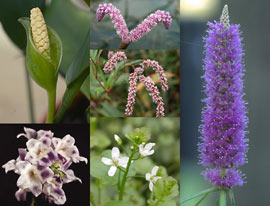Neptunia Lour.
puff, small leaf sensitive plant, dwarf sensitive plant, neptunia, water dead and awake
Fabaceae
pan-tropical
Neptunia oleracea Lour. (offered as N. aquatica and synonym N. prostrata (Lam.) Baill.)
information not available
may be considered a weed in some countries
small creeping or aquatic herb which either grows prostrateprostrate:
(adj) growing closely along the ground
near the waters edge or floats by forming spongy aerenchymaaerenchyma:
(n) plant tissue with large, gas-filled intercellular spaces that facilitates gaseous exchange and maintains buoyancy
around the stems
Perennial. Stems creeping, ascending, or floating; floating stems of spongy aerenchymaaerenchyma:
(n) plant tissue with large, gas-filled intercellular spaces that facilitates gaseous exchange and maintains buoyancy
. Leaves alternatealternate:
(adj) (of leaves) bearing one leaf per node; placed singly on the stem at different heights
 , compoundcompound:
, compoundcompound:
(adj) with two or more like parts, as in a compound leaf; divided into two or more subsidiary parts or orders, as in a compound inflorescence
(bipinnatebipinnate:
(adj) twice pinnate; having both primary and secondary pinnate divisions
), sensitive; stipules present but not apparent on floating stems. Inflorescenceinflorescence:
(n) the arrangement of flowers on the floral axis
 a spherical headhead:
a spherical headhead:
(n) inflorescence consisting of small closely packed stalkless flowers or florets arising at the same level on a flattened axis; of several types, including: discoid (composed entirely of disk flowers) and radiate (composed of central disk flowers and marginal ray flowers)
on an elongate pedunclepeduncle:
(n) the stalk of a flower cluster or inflorescence
. Flowers actinomorphicactinomorphic:
(adj) of flowers, having radial symmetry; capable of being bisected into identifical halves along more than one axis
, dimorphic: upper flowers bisexualbisexual:
(adj) having both male and female sexual reproductive structures on one individual or in one flower
, lower male and often sterilesterile:
(adj) lacking male and/or female reproductive parts; not producing fruit, seed, pollen, spores, etc.
; sepals small, tubulartubular:
(adj) (of a corolla, perianth, calyx tube or other structure) (1) tube-shaped; cylindrical: narrow and elongate with more or less straight sides; (2) having segments fused into a tube (of any shape)
, campanulatecampanulate:
(adj) bell-shaped
 , lobes 5; petals 5, yellow. Fruit a distinctive flattened seed pod. Dispersal by stem fragments and seeds.
, lobes 5; petals 5, yellow. Fruit a distinctive flattened seed pod. Dispersal by stem fragments and seeds.
wet ground, littorallittoral:
(adj) of or along the shore
, or in shallow water
Neptunia oleracea is an important vegetable herb in Southeast Asia. Eleven species are in the genus, with three aquatic. Neptunia aquatica is the name widely used in the aquarium and pond plant trade.